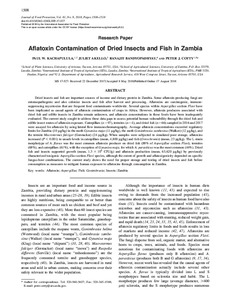| dc.contributor.author | Kachapulula, P.W, |
| dc.contributor.author | Akello, J. |
| dc.contributor.author | Bandyopadhyay, Ranajit |
| dc.contributor.author | Cotty, P.J. |
| dc.date.accessioned | 2019-12-04T11:26:30Z |
| dc.date.available | 2019-12-04T11:26:30Z |
| dc.date.issued | 2018-09 |
| dc.identifier.citation | Kachapulula, P.W., Akello, J., Bandyopadhyay, R. & Cotty, P.J. (2018). Aflatoxin contamination of dried insects and fish in Zambia. Journal of Food Protection, 81(9), 1508-1518. |
| dc.identifier.issn | 0362-028X |
| dc.identifier.uri | https://hdl.handle.net/20.500.12478/4631 |
| dc.description | Open Access Article; Published online: 17 Aug 2018 |
| dc.description.abstract | Dried insects and fish are important sources of income and dietary protein in Zambia. Some aflatoxin-producing fungi are entomopathogenic and also colonize insects and fish after harvest and processing. Aflatoxins are carcinogenic, immune-suppressing mycotoxins that are frequent food contaminants worldwide. Several species within Aspergillus section Flavi have been implicated as causal agents of aflatoxin contamination of crops in Africa. However, aflatoxin producers associated with dried fish and edible insects in Zambia remain unknown, and aflatoxin concentrations in these foods have been inadequately evaluated. The current study sought to address these data gaps to assess potential human vulnerability through the dried fish and edible insect routes of aflatoxin exposure. Caterpillars (n = 97), termites (n = 4), and dried fish (n = 66) sampled in 2016 and 2017 were assayed for aflatoxin by using lateral flow immunochromatography. Average aflatoxin concentrations exceeded regulatory limits for Zambia (10 μg/kg) in the moth Gynanisa maja (11 μg/kg), the moth Gonimbrasia zambesina (Walker) (12 μg/kg), and the termite Macrotermes falciger (Gerstacker) (24 μg/kg). When samples were subjected to simulated poor storage, aflatoxins increased (P < 0.001) to unsafe levels in caterpillars (mean, 4,800 μg/kg) and fish (Oreochromis) (mean, 23 μg/kg). The L strain morphotype of A. flavus was the most common aflatoxin producer on dried fish (88% of Aspergillus section Flavi), termites (68%), and caterpillars (61%), with the exception of Gynanisa maja, for which A. parasiticus was the most common (44%). Dried fish and insects supported growth (mean, 1.3 × 109 CFU/g) and aflatoxin production (mean, 63,620 μg/kg) by previously characterized toxigenic Aspergillus section Flavi species, although the extent of growth and aflatoxigenicity depended on specific fungus-host combinations. The current study shows the need for proper storage and testing of dried insects and fish before consumption as measures to mitigate human exposure to aflatoxins through consumption in Zambia. |
| dc.description.sponsorship | United States Agency for International Development |
| dc.format.extent | 1508-1518 |
| dc.language.iso | en |
| dc.rights | CC-BY-4.0 |
| dc.subject | Aspergillus |
| dc.subject | Fish |
| dc.subject | Gonimbrasia |
| dc.subject | Insects |
| dc.title | Aflatoxin contamination of dried insects and fish in Zambia |
| dc.type | Journal Article |
| dc.description.version | Peer Review |
| cg.contributor.crp | Agriculture for Nutrition and Health |
| cg.contributor.crp | Maize |
| cg.contributor.affiliation | University of Arizona |
| cg.contributor.affiliation | International Institute of Tropical Agriculture |
| cg.contributor.affiliation | United States Department of Agriculture |
| cg.coverage.region | Africa |
| cg.coverage.region | East Africa |
| cg.coverage.country | Zambia |
| cg.creator.identifier | Juliet Akello: 0000-0003-4780-4850 |
| cg.creator.identifier | Ranajit Bandyopadhyay: 0000-0003-2422-4298 |
| cg.researchtheme | PLANT PRODUCTION & HEALTH |
| cg.isijournal | ISI Journal |
| cg.authorship.types | CGIAR and advanced research institute |
| cg.iitasubject | Plant Health |
| cg.iitasubject | Plant Production |
| cg.journal | Journal of Food Protection |
| cg.howpublished | Formally Published |
| cg.accessibilitystatus | Open Access |
| local.dspaceid | 101312 |
| cg.targetaudience | Scientists |
| cg.identifier.doi | https://dx.doi.org/10.4315/0362-028X.JFP-17-527 |

